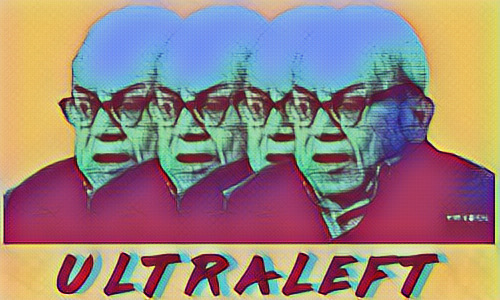American Mystics
Mormons, Adventists, New Thought, Quakers, and Pentecostals
Joseph Smith (December 23, 1805 – June 27, 1844) was an American religious leader and founder of Mormonism. Raised on the folklore of the Burned-Over District, Joseph Smith of Palmyra New York would go on to establish one of the fastest-growing religions of the contemporary world. Magic and myth were part of the firmament of the Smith household. According to historian D. Michael Quinn in his monumental study Early Mormonism and the Magic World View, Joseph Smith’s family owned magical charms, divining rods, amulets, a ceremonial dagger inscribed with astrological symbols of Scorpio and seals of Mars. In her 1845 oral memoir, the family matriarch, Lucy Mack Smith, recalled the Smith’s interest in “the faculty of Abrac.” In fact, Abrac or Abraxas, is a Gnostic term for God that also served as a magical incantation. It forms the root of a magic word known to every child: abracadabra.
For his part, Joseph Smith venerated the powers of the planet Jupiter, which was prominent in his astrological birth chart. Smith carries a protective Jupiter talisman up to his death, as reported by his first wife Emma according to D. Michael Quinn. The rebellious, spiritually adventuresome Smith began reporting divine visitations in the 1820s, which culminated in the angel called Moroni directing him to golden plates buried in the Hill Cumorah, near his home. It was the same place where local legend held that a lost tribe of Israel had made its last stand, a pillar of Smith’s later theology. Like Israel’s lost tribe, Smith and his followers would have to journey west to live out their destiny.
Ellen G. White (November 26, 1827 – July 16, 1915) was an author and co-founder of the Seventh Day Adventist Church. Along with other Adventist leaders such as Joseph Bates and her husband James White, she was instrumental within a small group of early Adventists who formed what became known as the Seventh Day Adventist Church.
White claimed to have received over 2,000 visions and dreams from God in public and private meetings throughout her life, which were witnessed by Adventist pioneers and the general public. She verbally described and published for public consumption the content of the alleged visions. The Adventist pioneers viewed these experiences as the Biblical gift of prophecy as outlined in Revelation 12:17 and Revelation 19:10 which describe the testimony of Jesus as the "spirit of prophecy."
Emma Curtis Hopkins (September 2, 1849 – April 8, 1925) was an American spiritual author and leader. She was involved in organizing the New Thought movement and was a primary theologian, teacher, writer, feminist, mystic, and prophet who ordained hundreds of people, including women. Emma Curtis Hopkins was called the "teacher of teachers" because a number of her students went on to found their own churches or to become prominent in the New Thought movement.
She would afterwards leave Christian Science to develop her own more eclectic form of metaphysical idealism, known later as New Thought, with certain mystical traits of Gnosticism. Though Hopkins felt much freer to make affinities with Theosophy and a wide variety of Eastern teachings.
Differing from Mary Baker Eddy's lead in speaking of God as both Mother and Father, Hopkins conceptualized the Trinity as three aspects of divinity, each playing a role in different historical epochs: God the Father, God the Son, and God the Mother-Spirit or Holy Comforter. Hopkins believed (as did Eddy, though not as parochially) that spiritual healing was the Second Coming of Christ into the world, and this was the hallmark of her early work. Hopkins also believed more specifically that the changing roles of women indicated their prominence in the Godhead, signaling a new epoch identified by the inclusion of the Mother aspect of God.
Rufus Jones (January 25, 1863 – June 16, 1948) was an American religious leader, writer, philosopher, and college professor. One of the most influential Quakers of the 20th century, he was a Quaker historian and theologian as well as a philosopher.
He distinguished between negating or negative mysticism (making contact with an impersonal force) and affirming or affirmative mysticism (making contact with a personal being). He upheld that God is a personal being with whom human beings could interact. He wrote in The Trail of Life in the Middle Years, "The essential characteristic of [mysticism] is the attainment of a personal conviction by an individual that the human spirit and the divine Spirit have met, have found each other, and are in mutual and reciprocal correspondence as spirit with Spirit." At the same time that he distinguished between negative and affirmative mysticism, he asserted that all negative mystics occasionally take the affirmative approach and that all affirmative mystics tread the negative path from time to time.
William Joseph Seymour (May 2, 1870 – September 28, 1922) was an African-American preacher who initiated the Azusa Street Revival, influential event in the rise of the Pentecostal and Charismatic movements. He was the second of eight children born to emancipated slaves and was raised in extreme poverty in Louisiana.
In 1906, Seymour moved to Los Angeles, California, where he preached the Pentecostal message and sparked the Azusa Street Revival. The revival drew large crowds of believers as well as media coverage that focused on the controversial religious practices as well as the racially integrated worship services, which violated the racial norms of the time. Seymour's leadership of the revival and publication of The Apostolic Faith newspaper launched him into prominence within the young Pentecostal movement. This passion for experiencing the Living God captured the hearts of thousands of people as Seymour lead the Azusa Street Revival.




Comments
Post a Comment